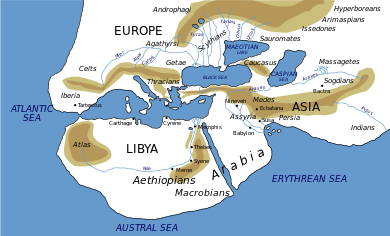Our website is made possible by displaying online advertisements to our visitors.
Please consider supporting us by disabling your ad blocker.
Aethiopia
This article needs additional citations for verification. (November 2016) |

Ancient Aethiopia, (Greek: Αἰθιοπία, romanized: Aithiopía) first appears as a geographical term in classical documents in reference to the skin color of the inhabitants of the upper Nile in northern Sudan, of areas south of the Sahara, and of certain areas in Asia. Its earliest mention is in the works of Homer: twice in the Iliad,[1] and three times in the Odyssey.[2] The Greek historian Herodotus uses the appellation to refer to regions south of Egypt when describing "Aethiopians," indicating Nubia, not the modern nation of Ethiopia.[3]
- ^ Cite error: The named reference
Homer1was invoked but never defined (see the help page). - ^ Cite error: The named reference
Homer2was invoked but never defined (see the help page). - ^ Diodorus Siculus (1933). "The Library of History". Digital Loeb Classical Library. doi:10.4159/dlcl.diodorus_siculus-library_history.1933. Retrieved 2024-09-26.
Previous Page Next Page


